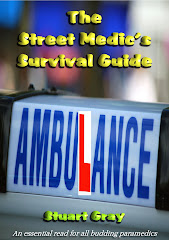Seven Emergencies: one treated on scene, one conveyed, one assisted-only and four taken by ambulance.
An early morning call to a 4 year-old girl with DIB and abdo pain took me to a small house in south London where I found a panicking mother and a rather calm little patient.
‘She has had this problem for weeks now and the doctor’s don’t seem to do anything about it’, mum said as I walked into the girl’s bedroom.
The girl was sitting up on her bed, looking right as rain. She beamed at me and I asked her mother some questions but my tiny patient decided she was going to answer them herself; it wasn’t the first time a minor had taken the role of lead during my interrogation – confident kids like to talk about their problems in their own way, that way mum (or dad) can’t ruin any planned embellishments or exaggerations.
I listened as she told me how she had woken up in the night with tummy ache and had felt a bit sick. She asked her mum to present me with the basin containing her latest expulsion, so that I could inspect it if I wanted to (it’s always nice to be made part of the family like that) and it was duly pushed under my nose. There was no vomit in it, just a little lump of sputum and a trickle of saliva – the vomit of the hopeful.
‘Ok, and have you been having breathing problems too?’ I asked.
‘Yes, but I’m better now.’
Mum was standing next to her with a concerned frown on her forehead. The little girl’s sister was supposed to be at school but obviously felt it necessary to be with her younger sibling during this time of crisis. That is until mum reminded her to get moving. She left the room reluctantly and headed off.
The crew arrived as I completed my obs, which revealed nothing really. The girl was a little ‘chesty’ but she had no temperature and there was nothing untoward with her vital signs. I began to wonder if she was avoiding pre-school. Nevertheless, she was taken with mum to hospital to be checked out and I left the scene shortly after completing my paperwork. I had started my shift with a little grin – not only had my patient been bold enough to try to pull the wool over my eyes as well as her mum’s, she had been confident enough to deliver a star performance. I couldn’t knock that.
A call to a 64 year-old female with back pain turned out to be a 64 year-old male with abdo pain. There’s nothing like getting a reverse product from a conversation, is there? He had recently been diagnosed with an infection of his testicles and had a history of diverticulitis, either of which might explain his current complaint. He was pale and quite obviously uncomfortable and he had waited for me longer than he needed to because, once again, I was wandering around his fortress estate looking for the correct door. It took me five or six minutes to get to him after I left the car.
There was nothing I could do for him immediately and when the crew arrived he was put into the chair and wheeled off to the ambulance (which was parked somewhere far away because they couldn’t gain access to the car park).
Hyperventilation is usually treated on scene. There is nothing emergent about this condition when it’s purely emotional (or psychological). My next call, for a 30 year-old female who was feeling faint took me to a hyperventilating woman. The crew were on scene at the same time, so I left them to work their magic on her. There’s no point in over-killing a perfectly straight-forward job.
A regular face next. He was inside the police office at Piccadilly Circus. He had gone in and collapsed dramatically and the call had been generated as '31 year-old male, fitting'. As I made my way there, it changed to ‘near faint’ and I knew I was going to meet someone I had dealt with before – especially in that location. I’ve yet to go to a genuine call there and I have been to that little office numerous times over the years – every faker in town goes there I think.
Sure enough, when I got inside a familiar face greeted me - well, he looked up in a sickly fashion and acknowledged my presence. You can see the physical change on someone’s face when you know they recognise you and they realise that their little game isn’t going to get them very far. He had that same disappointed look around his eyes when he caught sight of me.
I carried out my obs and asked him why he thought he needed an ambulance (this time). He changed his story over and over again. First he had a fit inside a theatre, then he was walking down the street when it happened. I pointed out that not many epileptics manage to walk into their local police office whilst having a seizure and he tried to change his story again. By now the crew had arrived and my ‘patient’ was already feeling much better. I explained the situation and they offered to check him out in the ambulance but he decided he was well enough to go home, so he declined, smiled and thanked us then wandered off into the crowd. I’ll see him again near Christmas I expect.
A combination call at an underground station in the late afternoon after that. I went to the aid of a 31 year-old woman who had fallen down steps at the station and twisted her ankle. It was swollen and discoloured and certainly looked sprained. During my chat with her an argument kicked off on the other side of the station office, where she had been brought after falling. A passenger was shouting and swearing at staff but I couldn’t catch what the theme was, so I asked them to keep it down while I was dealing with my patient.
The crew arrived to take her away and she seemed very upset about having to go to hospital. Lots of patients weep when they realise they have hurt themselves badly enough to warrant a trip to A&E.
I went out to my car and started on my paperwork but I didn’t complete it because a member of staff from the station knocked on my window and asked me to come back inside because he had an injured colleague. I went back down after calling this in as a ‘running call’ and was taken back into the station office. Another member of the underground staff sat in a chair with his leg elevated. There were a couple of police officers standing near him and a few of his colleagues were hovering.
It turns out the argument I had witnessed earlier was between this member of staff and a passenger who disagreed about the validity of his ticket to travel. A scuffle broke out, allegedly instigated by the passenger and my new patient ended up with a heavily bruised shin and cuts to his arm. On closer inspection the cuts looked like puncture wounds but I couldn’t work out what might have caused them. They were too round and small to be teeth marks, unless the passenger was a vampire (that might explain his desperate need to travel underground, even without a valid ticket – it was still daylight outside). It looked as though a small instrument had been used but the punctures were shallow, so a knife of some kind was unlikely.
There were no serious injuries and, as the patient swore his way through the explanation of what took place, I realised he wasn’t in any imminent danger of losing consciousness either, so I called Control and asked them to cancel the ambulance. They were more than happy for me to take the man to hospital myself because we had no ambulances to spare anyway.
On the way to hospital, he told me what he had done for a living before going underground. He was responsible for the upkeep of the clock in Big Ben’s tower. He used old pennies to weight the system precisely so that it wouldn’t go out of time. He also kept the works rust-free by cleaning and oiling them regularly. Fascinating.
If you have been ill for weeks and nothing has improved, you should really go and see your GP again. Calling an emergency ambulance for an on-going illness defeats the very purpose of our existence (acute emergency) and negates the purpose of a GP system. My last call, to a 33 year-old woman with a sore throat demonstrates this point. The call had been given as a DIB, which it was not, but once again a screening system that is just crying out to be abused had helped her get what she wanted – a blue light response for an ageing illness.
She had already been to her GP and been given antibiotics for a throat infection but they hadn’t cleared it. Her ‘DIB’ was panicky hyperventilation and nothing more. She had been suffering for three weeks but hadn’t bothered to go back to her doctor for another check and possibly some new antibiotics. Neither had she tried self-help. She had taken nothing to relieve her discomfort and simply lay there waiting for us to arrive and take her to an A&E department, where she could quite possibly spread her infection to vulnerable patients.
I know everyone is different but some real education is needed to stop this epidemic of ignorance about when an emergency response is needed.
One of the hospitals I frequently take patients to threatened to stop ambulances coming in because they had simply run out of beds and couldn’t cope with any more. This was on a busy week day but when I went in to look around at what they were dealing with, I found very few seriously ill or injured patients lying in cubicles. Most were drunk, drugged or had non-urgent problems. The reception area was full (standing room only) of minor problems that could have waited. Surely a crisis is coming?
Be safe.
Subscribe to:
Post Comments (Atom)















2 comments:
"She had taken nothing to relieve her discomfort and simply lay there waiting for us to arrive and take her to an A&E department"
That always used to amaze me when I worked on reception in A&E. No one seems to take painkillers before they land up at A&E. I had cause to go in on Saturday night, but only after having taken diclofenic, df118s and Sevredol... at that point I knew I needed to be there - and got a 3 day stay into the bargin!
Sue
I'm like that too. I've got to be dying before I'll trouble the pro's.
Post a Comment